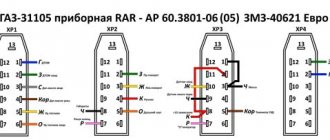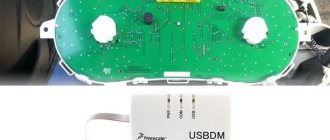A few words about how the battery-generator tandem works
Everyone, even a novice driver, knows that the battery interacts with the generator. After starting the engine, the battery goes into constant charging mode. After the engine speed increases, the voltage at the generator output also increases, which is not a “hum”.
In order to prevent the above described, a small relay-regulator is installed in the rotor excitation circuit, the task of which is to reduce the current to the optimal level, regardless of the engine speed. As a result, the voltage is maintained at the required level. The battery light comes on when there is no charging from the generator.
So, let's simulate the situation. You started the engine, but the battery light did not go out. What's the matter?
- Faulty relay-regulator, diode bridge;
- Poor tension of the generator belt, critical wear or belt slippage. Wear (play) of the generator bearing;
- Blown fuse or poor contact;
- Poor contact at the battery terminals, at the generator terminal or at the ground wire;
- Open circuit of the generator excitation circuit, serious wear of the generator brushes or brush holders;
- Wearing out the ignition switch is an option, but in this case several lights will light up at once.
The battery light is on on the dashboard of the VAZ-2114
No car can do without a battery. This element, like all others, has its own resource and must be replaced periodically. Today we will talk about what problems can arise with the battery during the operation of the car, how they manifest themselves and how they can be solved.
How car electronics work For those who are at least somewhat familiar with cars and what happens on the instrument panel, starting from the moment the key is first turned in the ignition, it is no secret that all indicators turn on with the first turn, and go out at the second - when the engine starts. On the standard dashboard there are indicators for oil, handbrake, and battery. On newer car models equipped with an ECU, there is an indicator such as “Check Engine” (check engine).
If any component of the car is faulty, the indicator light corresponding to it does not go out after starting the internal combustion engine. Thus, the smart panel lets the driver know that the car needs help. As for the battery indicator light, it may light up if the battery is malfunctioning (problems with the voltage supply or its complete absence).
Why doesn't the battery indicator go off? There are several possible reasons, and today we will try to understand each of them. Don’t immediately panic and start frantically wondering where to buy a new battery. The reason for the light not going out may be simple oxidation of the terminal. This problem can be solved in no time. However, more serious reasons should not be ruled out. Well, now everything is in order.
Fuse If fuse F16 on the instrument panel blows, other indicators may light up along with the battery light. The same thing often happens during contact oxidation. The solution is to check and (if necessary) clean the terminals, or replace the blown fuse.
Break of “zero” A break in the circuit of the “zero” wire that occurs for one reason or another leads to power failures in a combination of several devices. The solution is to ring the wiring and eliminate the break.
Ignition switch Often the cause of constant lighting of indicators (including the battery) is wear and tear on the ignition switch. The solution is to replace the ignition switch.
Ground Oxidation or simply poor contact of the wire going to ground also causes the battery indicator light to light continuously. The solution is to check the contact and fix the problem if one is found.
Problems with the generator The battery light may indicate a malfunction if the generator is not working properly. The main reasons for interruptions in its work are:
-Insufficient belt tension - check and correct. - If it is worn critically, replace it. - Wear of brushes - install new ones, if necessary, replace holders.
Also, the reason for the constant indication of the battery light on the dashboard may be a faulty alternator bearing. In this case, the battery is constantly undercharged due to the fact that the rotor rotation resistance increases. Also, a faulty bearing can simply jam. The solution is to replace the bearing before it fails completely.
Oxidation of contacts We mentioned this reason at the very beginning, as the easiest to solve. So, oxidation of the slip rings prevents the battery from charging normally. As a result, the indicator light lights up continuously. Solution - oxidized contacts can be cleaned roughly, using a knife or screwdriver, but it is better to carry out this procedure using WD-40.
Voltage regulator If this element is damaged, you will have to replace it - it cannot be repaired.
As you can see, there are many reasons that provoke the continuous burning of the indicator. At least a third of them can be solved quite simply. However, you shouldn’t leave things to chance. At the first signal, it is better to check what the problem is. A frivolous attitude towards malfunction signals can one day turn into a very unpleasant situation when, as a result of prolonged ignoring of the emergency indication, the battery completely fails at the most inopportune moment. For example, halfway between cities, on a deserted highway at night in winter.
(Visited 12 times, 1 visits today)
How to understand what exactly caused the light bulb to burn? How to fix the problem?
If the battery light is on while the engine is running, do not turn it off, open the hood and check the voltage at the battery terminals. If charging is supplied to the multimeter, the voltage should be 13.5-14.3V. If there is no charging, the voltage will be much lower - approximately 12V.
To solve the problem you will need:
- Two screwdrivers (flat and Phillips);
- “Control” (12V light bulb);
- Multimeter;
- Pliers, a knife and sandpaper to clean the contacts.
Why does the battery light on the car panel light up?
The dashboard of a car is the most important element of a technical device, since through the instruments there is a dialogue between man and machine. You should constantly monitor the indicators and indicators of the dashboard, monitoring the changes that occur or, conversely, the stability of the engine components.
What happens when the battery light on the panel lights up?
Let's figure out when you should pay attention to the lit battery light. It lights up every time you start the car engine, but when the engine is already running and the battery charging mechanism is working properly, the indicator should go out. That is, the fact that the battery charging light comes on in itself is a completely normal phenomenon, but the absence of its attenuation indicates a deviation in operation, namely: insufficient charging of the device.
Identification of faults and their causes
The illuminated battery light informs the car owner that a malfunction has occurred. As a rule, failures that result in a lack of charging occur either in the generator or in the car battery itself.
Battery fault. It is quite simple to identify deviations in the operation of the battery itself; you should remove the unit that aroused suspicion and put another one (new or working) in its place. And compare the dashboard indicators: if the light goes out, we can safely conclude that the problem is in the battery itself. And this problem can arise when the plates become sulfitated, which in some cases can be eliminated by repair. If the plates are shorted, the device must be replaced.
Installing a new battery
It should be remembered that the battery may be in good working order, but discharged due to leaving the headlights or car radio on while the engine is off. It is necessary to analyze your own actions that preceded the indicators of the lit battery light.
If, when replacing the device, the charging lamp is still on, then the reason lies in the incorrect operation of the generator.
Generator malfunction. The lack of voltage supply from a generator is easy to determine. It is enough to disconnect the wires from the battery with the engine turned off, measure the voltage, its readings should be in the range of 12.5-12.7 V. Then connect the wires to the battery, turn on the ignition and measure the voltage at the terminals again. The device readings should vary between 13.5-14 V. And as the speed increases, the voltage should also increase. Do not forget about personal protective equipment when performing these manipulations: be sure to wear rubber gloves.
If the voltage decreases with increasing speed, then the reason may lie in the wear of the generator “brushes” or diodes in the diode bridge.
A visual inspection can determine whether the belt is broken or loose. By pressing your fingers on the belt, you can determine its tension: if the belt bends less than 1-1.5 cm, then this may be the reason. The presence of oxidation of the terminals is also visually determined.
It's worth checking the generator wires. They tend to oxidize and burn out (a characteristic burning smell appears).
But there are also more global causes of device malfunction, such as: relay failure, rotor wear, circuit break, etc. Such problems can only be diagnosed by a specialist.
Troubleshooting
We figured out why the battery light is on. And when the causes are identified, you should begin to eliminate them:
- charging the battery will help restore its functionality if it is weakened due to long-term operation of electrical appliances with the engine turned off;
- Only a specialist can repair internal damage to the battery;
- loosening of the belt or its rupture can be eliminated by adjusting its tension or completely replacing it;
- oxidized terminals should be cleaned with fine-grained sandpaper;
- brushes and generator wires must be replaced;
- breakage of the generator winding, rotor wear and other serious defects, as a rule, precede the replacement of the unit on the recommendation of a specialist.
Cleaning the Battery Terminals
Listen to your car while driving and pay close attention to the dashboard readings. These simple steps help identify problems with your car at an early stage, which will help you avoid more serious consequences in the future.
You can share your personal experience of “eating” with the battery charging light on in the comments below the article.
AutoDriving.net
Let's look at different situations in which the battery light comes on.
- Situation one - the on-board voltmeter shows the charge, the battery light does not light up, the multimeter shows 12V at the battery terminals, while the battery itself is completely discharged.
Treatment: We strip the high voltage terminals and wires, after which we measure the voltage again. If this does not lead to anything, check the voltage at the “30” terminal of the generator. Connect one electrode of the multimeter to the generator terminal, the second to ground. If in this case the voltage is slightly higher than on the battery, “stripping” the “30” terminal. If necessary, change the wire that goes from the generator to the battery.
Reasons for the battery charging light to glow
Such bulbs are available in VAZ 2107 injection and carburetor type cars. If, after starting the engine, the indicator in the form of a battery continues to light on the instrument panel of the VAZ 2107, then the owner’s first opinion is that the generator is faulty. This is a correct opinion, and in order to find the exact cause, you will need to carry out diagnostic measures. The reasons for the glow of the lamp on the instrument panel are:
- Weakening of the tension of the generator belt, as well as its wear and damage.
- The fuse link burns out.
- Malfunction of the relay regulator or rectifier (diode) bridge.
- A break occurs in the generator winding.
- Poor contact at the battery terminals.
- Abrasion of graphite brushes on the generator.
- Lack of ground contact.
You cannot operate a vehicle with a glowing battery indicator on the instrument panel. At any moment, the battery can be discharged, since it is not receiving charge from the generator, and the car will simply stall. How long a vehicle can drive with a faulty generator depends on the quality of the battery, its charge and the vehicle’s electricity consumption. Typically this period of time ranges from 10 minutes to 2 hours.
THE BATTERY CHARGING CONTROL LIGHT IS ON WHEN THE IGNITION SWITCH IS OFF
THE BATTERY CHARGING CONTROL LIGHT IS LIGHTING WHEN THE IGNITION SWITCH IS OFF.
The light comes on when the engine is off and even when the key is removed from the ignition. When all this started, all the lamps described were really burning, but then they went out. When the engine is running, the red light is off, and when the engine is off, the light is on.
The situation is very interesting. I have not encountered such a malfunction yet, but from the diagram this is what you can understand.
- generator is faulty
- Unloading relay +15 does not turn off.
There may be three reasons.
The first contact group of the ignition switch is faulty,
how to check, remove the plastic casing around the steering column, it is secured with 3 screws with a torx head, they sit deep (two pieces) closer to the steering wheel, and one closer to the feet.
Disconnect the lock contact group from the connector. Has the lamp gone out? If it goes out, the problem is in the contact group.
second, if an alarm is installed, then the fault is in it. Disconnect the connector from the alarm unit. Has the lamp gone out? Then the fault is in the alarm unit. (But let me emphasize, the alarm system is not Volvo; Volvo alarm systems are not connected that way).
third, the unloading relay +15 is faulty, the switch contacts do not open. Pull the relay out of the mounting block. It is located under the hood; to gain access, unscrew the cover covering the mounting block on top where the fuses are located. The relay will be second from the left side closest to the fuses. Has the lamp gone out? This means either the relay is faulty, or there is a short circuit in the contact group of the ignition switch, or there is a malfunction of something not normally connected to this circuit. For example, alarms, radios. etc.
Be careful and careful. The fact is that the excitation winding of the generator does not turn off once the lamp is on. Accordingly, it can get warm. In addition, a lot of different energy consumers remain switched on in the car. Which, at best, will drain the battery. And in the worst case, a fire. Look for a defect, don’t delay diagnostics!
It’s better to stay out of harm’s way and disconnect the battery at night or during long periods of parking by removing the “+” terminal from the battery.
I’m not forcing you to go to a service center; you can diagnose everything yourself using a multimeter.
Sergey, hello. In my case, I had to change the generator, because... he was declared dead. From my correspondence. uCoz technologies are used











